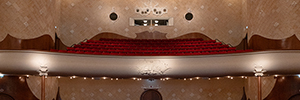Clear-Com ayuda en la formación aeroespacial de la Universidad de California
El Laboratorio de Vuelo Autónomo (AFL) of the Universidad Politécnica de California has a system Clear-Com integrado por un sistema Eclipse HX, cuatro paneles Iris, múltiples auriculares CC-400 e interfaces IP de la serie LQ para la conectividad.
 Las soluciones de vanguardia de Clear-Com han sido desplegadas en el Laboratorio de Vuelo Autónomo (AFL) of the Universidad Estatal Politécnica de California para preparar mejor a los estudiantes para los desafíos del mundo real de la comunicación y el control de los sistemas aéreos no tripulados (UAS).
Las soluciones de vanguardia de Clear-Com han sido desplegadas en el Laboratorio de Vuelo Autónomo (AFL) of the Universidad Estatal Politécnica de California para preparar mejor a los estudiantes para los desafíos del mundo real de la comunicación y el control de los sistemas aéreos no tripulados (UAS).
Con el fin de preparar mejor a los estudiantes para los desafíos del mundo real en materia de comunicación y control de los sistemas aéreos no tripulados (Unmanned Aerial Systems – UAS), la Universidad Politécnica del Estado de California ha desplegado un sistema Clear-Com en su Laboratorio de Vuelo Autónomo (AFL).
El objetivo de este programa es que los estudiantes adquieran una experiencia práctica utilizando la infraestructura de comunicaciones estándar de la industria, explica el profesor asociado, Paulo Iscold. “Queremos enseñar a los estudiantes de ingeniería aeroespacial a manejar sistemas de comunicación y a trabajar en equipo de forma eficaz y productiva en una estación de control en tierra”.
 El aprendizaje y la comprensión sobre cómo fomentar las comunicaciones fluidas entre la aeronave autónoma (con piloto de reserva a bordo) y el suelo es una misión crítica. “Nuestra estación de tierra es una de las partes más importantes de este laboratorio para introducir a los estudiantes en la forma de hablar por intercomunicadores. Por eso elegimos Clear-Com”, afirma Iscold. “Con Clear-Com, vamos más allá porque los estudiantes no sólo hablan con la aeronave, sino que con otros dentro de la sala de control, aprendiendo a trabajar colectivamente en los mismos problemas”.
El aprendizaje y la comprensión sobre cómo fomentar las comunicaciones fluidas entre la aeronave autónoma (con piloto de reserva a bordo) y el suelo es una misión crítica. “Nuestra estación de tierra es una de las partes más importantes de este laboratorio para introducir a los estudiantes en la forma de hablar por intercomunicadores. Por eso elegimos Clear-Com”, afirma Iscold. “Con Clear-Com, vamos más allá porque los estudiantes no sólo hablan con la aeronave, sino que con otros dentro de la sala de control, aprendiendo a trabajar colectivamente en los mismos problemas”.
Los estudiantes de ingeniería aeroespacial acumulan una gran cantidad de conocimientos técnicos durante sus estudios. However, los puntos más delicados del diseño de sistemas de comunicación y los protocolos operativos -Simplex frente a Dúplex, comunicaciones Partyline frente a punto a punto, e incluso la disciplina general de las comunicaciones- no suelen enseñarse en programas similares.
 “La analogía que utilizo es que enseñamos a los estudiantes a ser músicos, pero nunca les dejamos tocar el instrumento”, aclara Iscold. “En este caso, el objetivo es enseñar a los alumnos a utilizar su ‘instrumento’ de forma instintiva, no sólo ensayando para futuras actuaciones con simuladores de vuelo, sino poniéndolos esencialmente en el escenario con aviones tripulados. Con las simulaciones, podemos hacer una pausa, quitarnos los auriculares y preguntarnos: ¿Cómo podemos mejorar? ¿Cómo podemos ser más eficaces? Con los aviones, no hay botón de pausa”.
“La analogía que utilizo es que enseñamos a los estudiantes a ser músicos, pero nunca les dejamos tocar el instrumento”, aclara Iscold. “En este caso, el objetivo es enseñar a los alumnos a utilizar su ‘instrumento’ de forma instintiva, no sólo ensayando para futuras actuaciones con simuladores de vuelo, sino poniéndolos esencialmente en el escenario con aviones tripulados. Con las simulaciones, podemos hacer una pausa, quitarnos los auriculares y preguntarnos: ¿Cómo podemos mejorar? ¿Cómo podemos ser más eficaces? Con los aviones, no hay botón de pausa”.
El objetivo es proporcionar experiencia práctica utilizando las herramientas y los sistemas que los graduados encontrarán en los entornos operativos del mundo real. Aprenderán a informar a los pilotos de prueba y a ver y analizar los datos en tiempo real. Son habilidades blandas que, según Iscold, los ingenieros aeroespaciales “rara vez aprenden en la escuela y, en cambio, tienen que desarrollar durante su vida profesional”.
Construida desde cero durante el verano de este año, la parte de la estación de tierra del AFL cuenta con un sistema Clear-Com compuesto por un marco de sistema de intercomunicación matricial Eclipse HX (con una tarjeta de interfaz IP de alta densidad E-IPA), cuatro paneles Iris, múltiples auriculares CC-400 and interfaces IP of the serie LQ para la conectividad.
In addition, el laboratorio incorporará la aplicación móvil Agent-IC de Clear-Com y la herramienta Station-IC Virtual Desktop Client para proporcionar a los estudiantes conectividad remota. Dado que el programa atiende a 120 estudiantes anualmente, y sólo diez pueden ocupar el laboratorio simultáneamente, la conectividad remota es un activo necesario.
Mientras rotan los estudiantes dentro y fuera del laboratorio, las capacidades proporcionadas por Agent-IC y Station-IC permiten a los que no están físicamente presentes escuchar, aprender y comprender el lenguaje y el flujo de la comunicación adecuada.
“Nuestra estación de tierra se parece a lo que se ve en los lanzamientos de cohetes de la NASA o de Space X”, explica Iscold, “con ingenieros sentados frente a las pantallas mientras los datos bajan por ellas, comunicándose entre sí, con el director de vuelo y el control del tráfico aéreo. Tenemos que enseñar a los estudiantes a manejar toda esa comunicación simultáneamente, por lo que la flexibilidad que ofrece Clear-Com fue un factor determinante para nosotros”.
La integración de una licencia HCI en la matriz hace que el sistema sea aún más sofisticado que muchas estaciones de trabajo reales. “Estamos utilizando un intercomunicador en varias frecuencias y cambiándolas en los demás puestos de control. Esa flexibilidad -y la capacidad de integrar Clear-Com con otros componentes en la estación de tierra- era muy importante para nosotros.”
You liked this article?
Subscribe to our Feed And you won't miss a thing.















